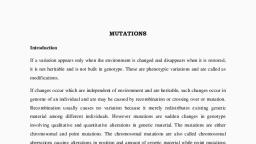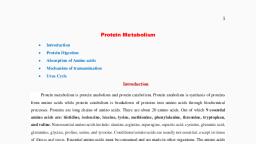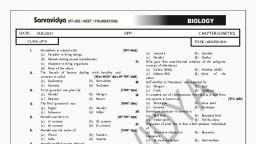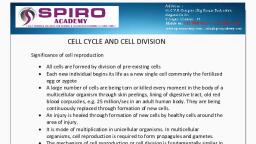Page 1 :
LINKAGE, The gene which determines the characters of an individual are carried on the chromosomes and an individual has, many genes for determination of various characters. As there are more genes than the number of chromosomes it can, be expected that the chromosomes contains more genes than the number of chromosomes. The genes for the, different characters may be either located on same or different chromosomes. When genes are present on different, chromosomes the characters they control appears in next generation are either together or apart. But if genes are, situated on same chromosomes and are fairly close to each other they tend to be inherited together. This type of, coexistence of two or more genes to remain together during inheritance is called as linkage., AABB, , ×, , aabb, , AB, , ×, , ab, , AB / ab, , F1, , TEST CROSS, AB/ab × ab/ab, AB , ab × ab, , Gametes, , AB/ab , ab/ab, 1 : 1, ARRANGEMENT OF LINKED GENES, According to Bateson and Punnet the linkage may be either cis or trans type., 1., , 2., , CIS or COUPLING phase –, When two dominant genes are linked on same chromosome and the recessive alleles on the homologous, chromosomes then the genes are said to be in coupling or cis phase., , A, , a, , B, , b, , TRANS OR REPULSION Phase –, When the dominant and recessive alleles are present on same chromosome then the arrangement of linked, genes is said to be in trans or repulsion phase., , A, , a, , B, , B
Page 2 :
Types of linkage, T.H. Morgan with his investigations on Drosophila and other organisms have found two types of linkage., 1. COMPLETE LINKAGE, 2. INCOMPLETE LINKAGE, 1. COMPLETE LINKAGE, When the linked genes are so closely located in the same chromosome that they inherit in the same, linkage group for one or more generations in regular manner then they are called as completely linked, genes and the phenomenon of their inheritance is called as complete linkage., Ex. The phenomenon of complete linkage is observed in male drosophila and other organisms like tomato,, maize, pea, rice, poultry, man etc., In Drosophila Grey body colour ( G ) is dominant over Black body colour ( g ) and Long wings ( L ) are, dominant over vestigial wings ( l) . A grey bodied long winged Drosophila ( GL/GL ) is crossed with, Black bodied vestigial winged winged Drosophila ( gl/gl). In F 1 generation grey bodied long winged, Drosophila ( GL/gl ) is observed. When this F1 generation is test crossed, in F 2 generation instead of 1: 1, :1:1 ratio we get 1:1 ratio i.e. 1 grey long and 1 black vestigial as shown below., , 2. INCOMPLETE LINKAGE - In many cases the gene pairs in most linkage group assort independently, of each other. Therefore the linkage is not complete. Incomplete linkage occurs in female Drosophila as, shown below., Ex. When a hybrid Grey Bodied long winged Drosophila ( GL/gl) is crossed with black bodied vestigial, winged Drosophila, four kinds of flies were obtained these were Grey Vestigial ( 41.1%), Black Long (, 41.1%),Black Vestigial ( 8.5%) and Grey Long ( 8.5%) . Thus in addition to two parental Genotypes, two, new kinds of flies i.e. black vestigial and grey long were obtained. This indicates that recombination has, occurred as result of crossing over.
Page 3 :
CROSSING OVER, Every character of an organism is determined by a pair of genes called as allelomorphs or alleles. Such a pair of, allele occupies same locus on homologous pair of chromosomes. The genes located on same chromosome are said to, be linked with each other and forms linkage groups. In complete linkage the linked genes are transferred together to, the next generation. And in incomplete linkage the genes are exchanged between nonsister chromatids of, corresponding homologous chromosomes by the act of “ Crossing Over”. Thus crossing over is defined as “ The, process in which interchange of corresponding segments of nonsister chromatids of homologous chromosomes takes, place resulting in new combinations of genes”. It occurs in meiosis during gamete formation., , MECHANISM OF CROSSING OVER, Crossing over occurs in prolonged prophase of first meiotic division of gametogenesis. The mechanism of crossing, over is completed through following steps., 1., 2., 3., 4., , Pairing or synapsis, Duplication of chromosomes, Crossing over, Terminalization, 1., , 2., , 3., , 4., , Pairing or synapsis, During zygotene stage of prophase I of meiosis occurring in developing cells, the homologous, chromosomes comes close to each other and pairing of them takes place and is called as synapsis., Synapsis provides mechanical basis of heredity and variation. It is started during zygotene stage when, homologous chromosomes are held to make contact with each other at one or more points from which, synapsis extends into adjacent regions and it ends or reaches maximum in pachytene stage after which, the homologus chromosomes fall apart except the regions of chiasmata. Thus synapsis is the phase of, prolonged and close contact of homologous chromosomes due to attraction between two exactly, identical or homologous regions. Thus resulting pairs of chromosomes are called as bivalents., Duplication of Chromosomes, The synapsis is followed by duplication of chromosomes. During this stage each homologous, chromosome of a bivalent splits longitudinally and forms identical sister chromatids, so that each, bivalent is now composed of four chromatids. A bivalent chromosome having four chromatids is called, as tetrad., Crossing over, The crossing over occurs in homologous chromosomes only during tetrad stage. During the process of, crossing over two nonsister chromatids first break at corresponding points due to activity of nuclear, enzyme called as endonuclease. Then a chromatid segment on one side of each break connects with the, segment on the opposite side of the break, so that the two nonsister chromatids cross each other at the, point of break and exchange. The fusion of chromosomal segments with that of opposite one takes, place due to action of an enzyme called as ligase., The crossing of two chromatidsis called as chiasma or chiasmata formation and the resultant cross a, chiasma or chiasmata. The crossing over thus includes the breaking of chromatid segments, their, transposition and fusion., Terminalization, After the completion of crossing over the nonsister chromatids starts to repel each other because the, force of synpsis attraction between them decreases. The chromatids separates progressively from the, centromere towards the chiasma and the chiasma itself moves in a zipper fashion towards the end of
Page 4 :
tetrad. The movement of chiasma towards the end is called as terminalization. Due to terminalization, homologous chromosomes are separated., , Cytological evidence of crossing over, Except the visible chiasma there is no other cytological observation to substantiate whether actual exchange, of chromosomal segments take place or not. In order to demonstrate the phenomenon of crossing over, special experiments were designed by C.Stern in Drosophila., Stern used two strains of Drosophilla, each of which had a special X chromosome so that they could be, distinguished morphologically from each other and also from the normal X chromosome. To distinguish the, X chromosome of the female he placed a portion of Y chromosome on one X chromosome and the other X, chromosome was broken into two pieces., Two sex linked genes were located on upper piece of broken X chromosome. These genes were Carnation, color ( r ) of eye and other gene for bar Shape ( B ) of eye. Carnation is recessive to red ( R ) while bar, shape is dominant over round shape ( b). another X chromosome with attached piece of Y chromosome had, two normal genes i.e. Red color of eye ( R ) and round shape of eye ( b )., In above example the heterozygous female produced four types of eggs due to crossing over, of which, two eggs were crossovers and two eggs were noncrossovers and the progeny produce were,, a) Carnation Bar ( rrBb ) with one broken X chromosome and other normal X chromosome from male., b) Red Round (Rrbb ) with X chromosome with attached segment of Y chromosome and other normal X, chromosome from male., c) Red Barred ( RrBb ) with one X chromosome having attached segment of Y chromosome and is also, broken and other normal X chromosome., d) Carnation Round ( rrbb ) with unbroken X chromosome without attached segment of Y chromosome, and other normal X chromosome from male., From above example it is evident that the two crosses of noncrossovers i.e. one X chromosome with, broken segment and other X chromosome with attached segment of Y chromosome. In the crossover, types the maternal X chromosome resulted from crossing over has its broken segments along with
Page 5 :
attached segment of Y chromosome ( RB ) while other X chromosome was normal ( rb ). Thus in, Sterns experiment genetic crossing over was accompanied by cytological crossing over.






















































